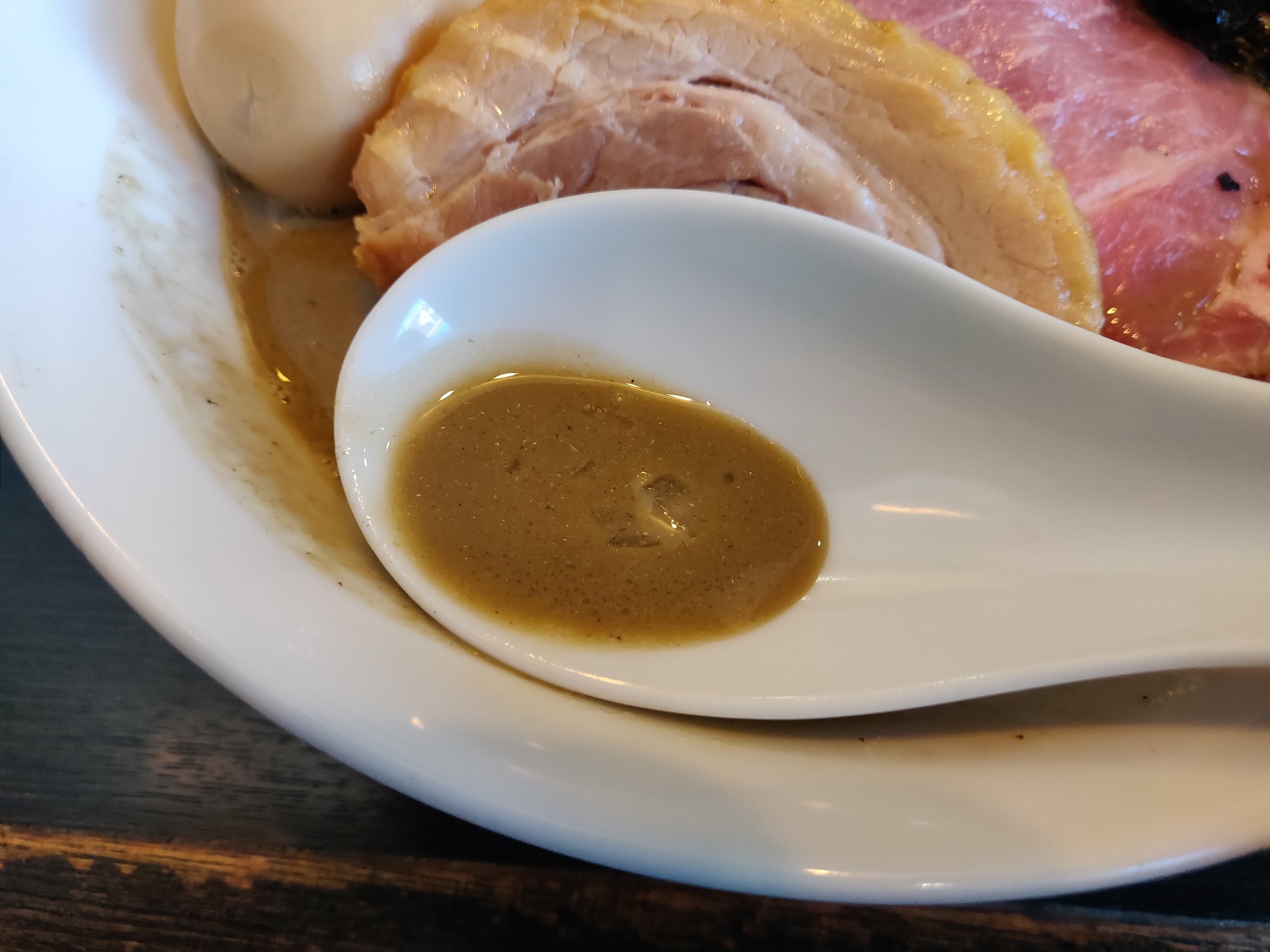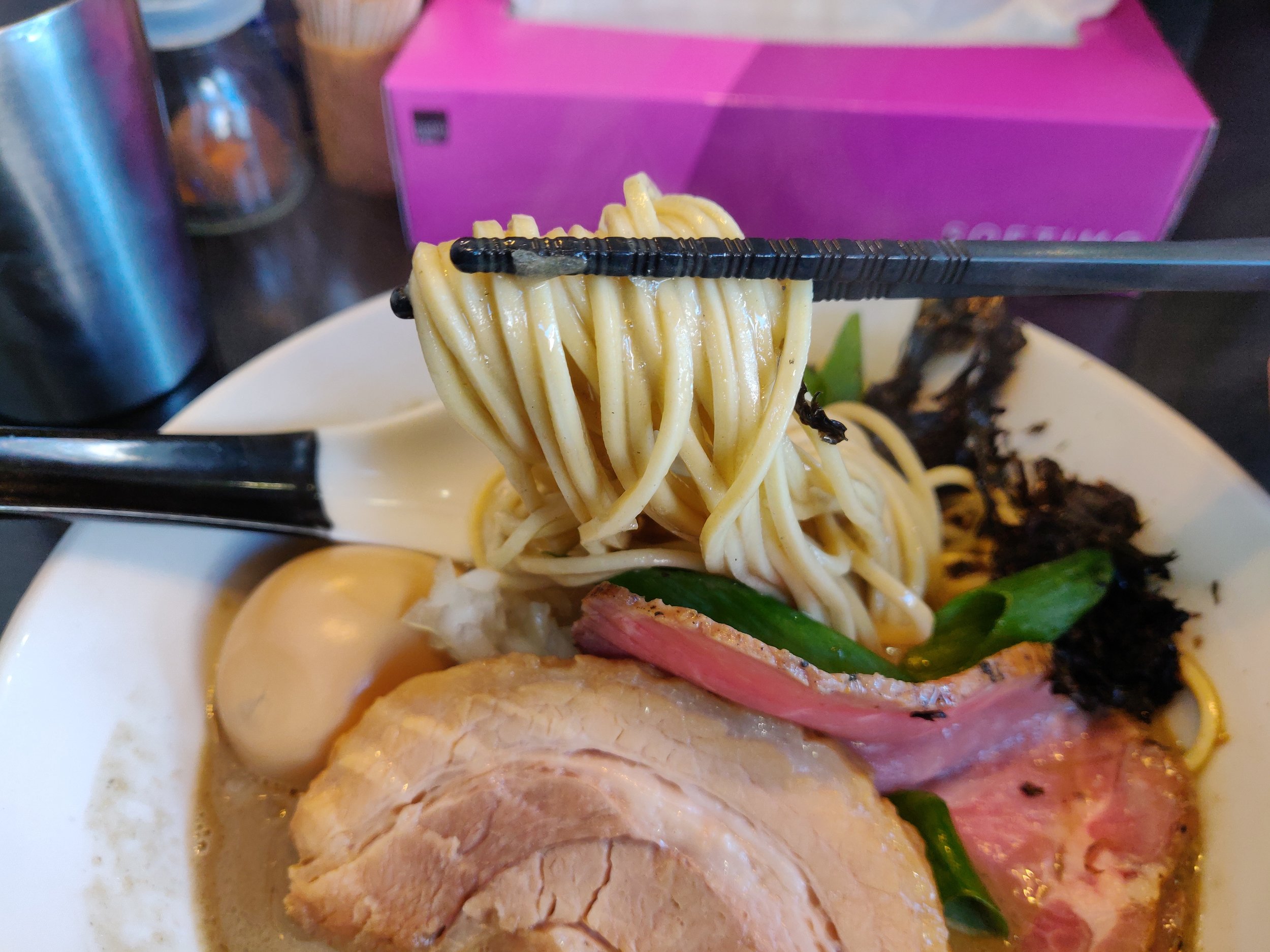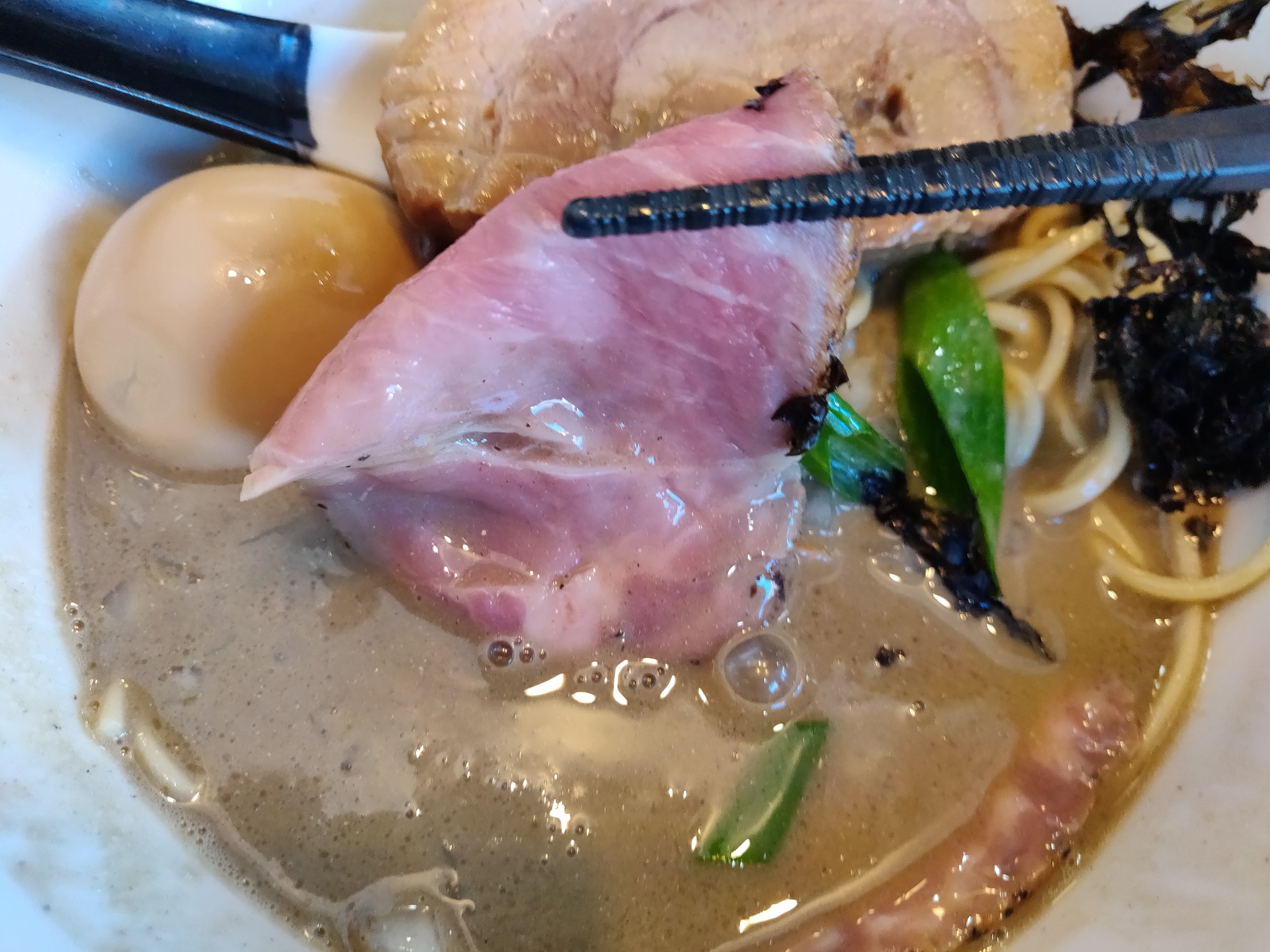Hiwamatanoboru (陽はまたのぼる); Next Great Ramen Trend?, Ayase
If you follow my instagram @ramenguidejapan, you may know that one of my favorite ramen varieties is the Noukou Niboshi ramen. For those who don’t know what that entails, the broth is made through a long and arduous simmer of thousands of pounds of Niboshi, dried sardines to create an incredibly fishy and sodium rich flavor. The most famous shop for this genre is Chuka Soba Ibuki up in Itabashi, but Hiwamatanoboru in Ayase is making a run at challenging Ibuki for the throne. While in line, I could already smell the incredible Niboshi aroma and my mouth was salivating from that smell and excited for what was to come. The shop itself is a short walk from Ayase station on the Chiyoda line and is the station right before Kameari, so if you were already looking to try Tsukemen Michi, you might as well kill two birds with one stone by coming here after.
Apologies in advance for the poor photo of the ticket machine, but as it is quite a popular ramen shop, I was in a bit of a rush as to not interfere with other customers. Not a lot of foreign customers and patrons make it all the way to Ayase and try a bowl of their Niboshi ramen so I wasn’t surprised by the lack of English menus. Luckily for you, I’ll translate the ticket machine here so you’ll know exactly what to buy when you arrive. On the top left in orange is the Niboshi Soba, Niboshi Ajitama Soba (with marinated soft boiled egg), and Tokusei Niboshi Soba (extra toppings). To the right of that in brown is the Noukou Soba (thicker, more dense Niboshi soba), Noukou Ajitama Soba, and Tokusei Noukou Soba. on the row right below in yellow is the Shio Niboshi Soba (salt seasoning tare), Shio Niboshi Ajitama Soba, and the Tokusei Shio Niboshi Soba. The lone pink button on the row right below that is that Char Siu (roast pork) topping and the green buttons are the tsukemen option (in varying sizes from small to large) which have been unavailable for some time now. The row below that is the other toppings of Ajitama (soft boiled egg), Nori (dried seaweed), Tamanegi (diced onions), and Atsugiri Buta (thick cut pork char siu). The green button on this row are the Ajitama Tsukemen in varying sizes from small to large (again, unavailable for some time now). The light orange buttons below that are the rice options of Gohan (regular rice), Buta Meshi (rice with pork char siu), and Buta Meshi Chu (medium size). The dark blue button is beer, and the green buttons are the unavailable Tokusei Tsukemen options. The red buttons are specialty items which will be displayed on a poster if available (not offered on my visit). I opted for the Tokusei Noukou Soba and ordered a Kaedama (extra noodles) which you pay in cash at the table when you are ready (200 yen).
Pictured is my Tokusei Noukou Soba. The toppings offered on the Tokusei version is a cut of thick slice pork char siu and marinated soft boiled egg in addition to the pinkish, thin pork char siu and diced onions which comes regularly with the bowl. Starting with the soup, to which I can only describe as phenomenal, I was immediately hit with that fantastically, fishy umami flavor. If you find yourself coming in from Tokyo to Ayase for Hiwamatonoboru, I have to stress getting the Noukou version of their ramen. Not only is it served in limited quantities due to the sheer amount of Niboshi needed to make this condensed soup, but it is a rarity in the Tokyo ramen scene to begin with. Only a handful of ramen shops offer a Niboshi ramen at this level of thickness and density which I believe is a travesty. It’s no wonder that the only ones I can think of that offer this style are all in tabelog.com’s top 100 ramen restaurants of Tokyo. It’s seriously that good. What makes it special is the quantity and quality of the Niboshi used as well as the time needed to simmer it long enough to break it down in to this wet, cement consistency. The result of the two ends up in a broth with all the protein and bones of the fish broken down in to a drinkable soup that is packed with flavor in every spoonful. Of course, I can only recommend this shop in general to hardcore Niboshi, dried sardine lovers as they only offer this soup type, but is definitely worth it if you’re not adverse to the flavors of fish in your ramen.
Noodles at Hiwamatanoboru is a high alkaline, thin noodle reminiscent of ones used for a Tonkotsu ramen style. Makes sense as this ramen is essentially the fish version of the pork tonkotsu soup and the noodles act in the same way for both, soaking in flavors without attracting too much attention to it. Since the soup is so thick and dense, it would be quite a mouthful trying to take down some flavorful, thick noodles with it so I thought the thinness of the noodles worked perfectly with the soup. Next up are the two char siu types given in the tokusei versions of the ramen. The thin cut, slightly rare pork version comes with the regular ramen and is quite meaty and has a high protein to fat ratio which holds up well to the thick soup. The residual heat of the soup will continue to cook the thin slice as it sits in your bowl so eat it at the point you most prefer in terms of cooking length. It’s not very heavily seasoned so it takes on the flavors of the soup, but gives a nice variety in texture from the soup and noodles. Now, the reason why I opted for the Tokusei version was to get a slice of the thick cut pork char siu pictured above. The thick cut is the other side of the spectrum from the thin cut in terms of protein to fat ratio and flavor. Despite its thickness, the amount of fat on this slice, as well as the intense cooking of the pork, makes it so it melts in your mouth as soon as it touches your tongue. Served chilled, it’ll keep its shape despite being in the pipping hot soup, but I would recommend eating it as soon as possible so that it doesn’t start falling apart mid meal. The soft boiled egg is similar in that it’ll keep cooking through the residual heat of the soup so eat it sooner rather than later if you’re a fan of runny yolk. Finally a bit of seaweed and diced onions round out the bowl which is definitely needed as the tangy flavors of the two help cut through the high sodium of the soup.
As with all Noukou Niboshi ramen restaurants, Kaedama (extra noodles) is a must. Just like Ibuki and Koike, it is recommended you eat the noodles as is first before putting them in to your remaining soup. The Kaedama has a bit of vinegar, fish sauce, Gyofun (fish powder), slivers of char siu, and diced onions included in the bowl. Mix all of the components together to get an incredible change of flavor from the thick, Noukou Niboshi soup. Despite the addition of the fish sauce, because of how dense the Noukou soup is, you’ll find that Kaedama to be quite light in comparison. The acidity of the vinegar helps cleanse your palette for a bit and is refreshing mid meal. Once you’ve appreciated the taste of just the noodles, go ahead and put the rest in your soup. The addition of the vinegar and fish sauce cuts through the dense soup and actually turns the bowl in to a completely different flavor. In my opinion, the kaedama isn’t just an option for more noodles, but a necessity to thoroughly enjoy the ramen in every way possible.
If you’re staying in central Tokyo, Ayase is quite the trek just for ramen. However, for those hardcore ramen aficionados, I think a visit to this side of Tokyo is a necessity to try the full spectrum of Tokyo ramen varieties available. Of course, those adverse to fish flavors may want to skip this shop, but for those looking for something a bit different from the monotonous tonkotsu and shoyu ramen shops in Shinjuku, take a leap of faith and try some Niboshi ramen. At the very least you’ll have an expanded ramen taste palette and a story to tell your friends back home. If you do end up coming here, be sure to let me know on my social media platforms or in the comment section below. Hope you enjoy what may be my top five favorite ramen restaurant in Tokyo!







